|
INDY PRO SERIES CAR SPECIFICATIONS
(Courtesy of IndyPro Series):
ENGINE PROGRAM:

Manufacturer: Infiniti
Capacity: 3.5 Liters
Configuration: 90-degree V8
Horsepower: 450 @ 8,200 RPM
Infiniti is the
sole engine manufacturer of the Indy Pro SeriesT. The series
uses a 3.5-liter racing version of the engine found in the
Infiniti Q45 luxury performance sedan.
The Infiniti Q45
has always focused on performance in the highly-competitive
premium luxury class, and one of its outstanding
characteristics is its powerful 4.5-liter, V8 engine that
produces up to 340 horsepower. The Q45 represents the pinnacle
of Infiniti's performance technology. The fact that the Indy
Pro Series selected this production engine to power its racing
series is one of the best accolades one could receive. It is a
testament to the Infiniti brand that the Menards Infiniti Pro
Series can take its production parts to use on the race cars
under extreme racing conditions at speeds in excess of 180
mph.
As Infiniti enters
its 16th model year for 2005, the expanded lineup includes the
QX56 full-size luxury SUV, Q45 performance luxury sedan,
all-new M45 performance sport sedan, FX35 and FX45 premium
crossover SUVs, G35 Sport Coupe and Sport Sedan,. This lineup
has earned praise for its advanced technology, leading-edge
safety features, lightweight and aerodynamic body designs,
innovative styling and attention to comfort and luxury. A
network of over 160 dealers in the United States supports
Infiniti, the luxury division of Nissan North America, Inc.
CHASSIS PROGRAM:

|
Chassis Regulations |
|
Type:
|
Open-wheel,
single-seat, open-cockpit and ground-effect underbody;
outboard wings front and rear |
|
Construction: |
Monocoque
contains cockpit, fuel cell and front suspension; engine
is stressed (integral) member of chassis; rear assembly
contains gearbox and rear suspension members |
|
Materials: |
Carbon
fiber and composites |
|
Weight: |
1,430 pounds
minimum, including all lubricants and coolants used during
the event, but does not include fuel or driver
|
|
Length: |
191.5
inches minimum |
|
Width:
|
75 inches,
plus or minus 1/2 inch. |
|
Wheelbase: |
117
inches. |
|
Wheel
Size: |
15-inch
diameter x 10 front; 15-inch diameter x 14 rear.
|
|
Tires: |
Firestone
Firehawk |
|
Gearbox: |
Ricardo Six
forward gears, sequential shifter |
|
Fuel Cell: |
Single,
rupture-proof cell, 25 U.S. gallons (standard)
|
|
Cost: |
$115,000
(including data acquisition system) |
|
Manufacturers: |
Dallara
Automobili, Italy |
TIRE PROGRAM:

Nashville-based Bridgestone/Firestone North American Tire, LLC is a subsidiary of Bridgestone/Firestone Americas Holding, Inc., whose parent company, Bridgestone Corporation, is the world's largest tire and rubber company. BFNT develops, manufactures and markets Bridgestone, Firestone, Dayton and associate and private brand tires. The company is focused on wholesale and original equipment markets, supplying passenger, light truck, commercial vehicle, off-road, agriculture and other tires to its customers in North America.
Fortunately, Indy Pro Series cars don't have to run in the snow.
Aside from lacking a heater, their tires wouldn't measure up to the
slick roads.
Follow these simple directions to get a look at Firestone tire tread
depth:
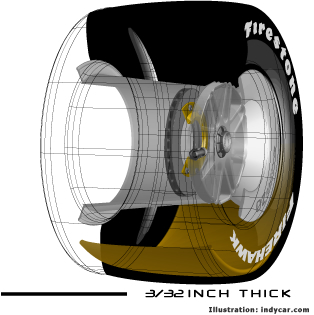
Step A:
Remove credit card from wallet/purse.
Step B:
Examine thickness of card.
Step C:
Note that tire tread depth on Indy Pro Series cars is about as thick
as the card (3/32nds of an
inch).
Step D:
Be
thankful your passenger car tires have more trend depth.
Fast facts about tires on Indy Pro Series cars:
-- Are 15 inches in diameter.
-- Are 10 inches wide and weigh about 30 pounds on the front and 14
inches and weigh about 30 pounds on the rear.
-- At any given moment during a race, the total area of all four
tires that is in contact with the track is equal to about one square
foot (about the size of a sheet of notebook paper).
-- At speed, tread area approaches the temperature of boiling water
(212 degrees Fahrenheit). The tread actually becomes tar-like in
consistency.
-- Are inflated with filtered air or nitrogen to remove moisture and
computer balanced.
-- Ambient temperature can have an impact on tires.
Rules of the road
Indy Pro Series teams must pay attention to the number of tires at
their disposal on race weekends.
The three sets Firestone tires provided to teams are aligned with
race distances. Teams must take into account that the fixed number
is for practice, qualifying and the race.
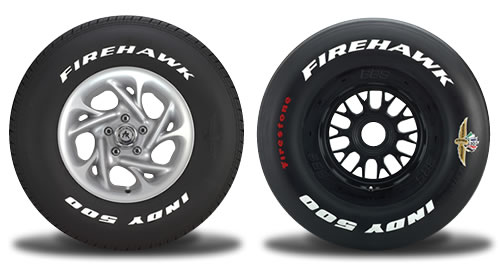
|
Street Tire |
Race Tire |
|
Width:
Weight:
Lifetime:
Tread pattern:
Tread Thickness:
Rubber footprint |
Approx. 8 inches
33 pounds
Up to 80,000 miles
Various
Under 1/2 inch
Significant amount of void due to tread pattern |
Width:
Weight:
Lifetime:
Tread pattern:
Tread Thickness:
Rubber footprint |
14 inches
22 pounds
100 miles
None
3/32 inch
100% contact |
SAFER BARRIER:
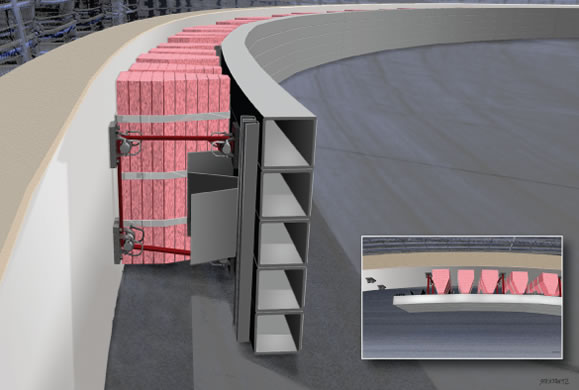
Under development by the IRL and the University of
Nebraska-Lincoln's Midwest Roadside Safety Facility since 1998, the
SAFER Barrier was designed to reduce the level of impacts by IRL
cars.
The SAFER Barrier is constructed in 20-foot modules, with each
module consisting of four rectangular steel tubes, welded together,
to form a unified element. The modules are connected with four
internal steel splices. Bundles of 2-inch-thick sheets of extruded,
closed-cell polystyrene are placed between the concrete wall and the
steel tubing modules.
In addition to the Indianapolis Motor Speedway, more than 25 tracks
which play host to auto racing events have installed the SAFER
Barrier. As of January 2005, 11 of the 14 oval tracks on the IRL
schedule had installed the system in all four turns.
Speedway and IRL officials, working with NASCAR and the Midwest
Roadside Safety Facility, continue to try to improve the barrier
through test crashes at the Midwest Roadside Safety Facility in
Nebraska and analysis of all crash data. Every time the SAFER is
impacted, the developers look at the results, driver injuries,
damage to the car, and damage to the SAFER system to determine if
any modification could be made to improve those results.
Since its introduction, the SAFER Barrier has earned four major
awards that has been presented to honor Tony George and the SAFER
Barrier development team.
TIMING AND SCORING:
1. A radio transponder is installed on the side of each car, 33
inches from the tip of the nose cone.

2.
Multiple cables buried beneath the track record each car's passing
and transmit the data via a trackside decoder to the timing and
scoring booth. The information is
then fed to the TAG Heuer timing and scoring stand located in the
pit lane at the start/finish line is a camera which takes a picture
every ten-thousandth of a
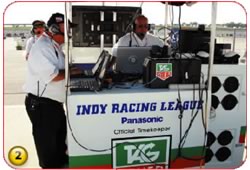 second. The camera played a vital role in
determining the race winner at Kansas in 2004 when Buddy Rice edged Vitor Meira by .0051 of a second (below). second. The camera played a vital role in
determining the race winner at Kansas in 2004 when Buddy Rice edged Vitor Meira by .0051 of a second (below).
3.
The information is assimilated and sent out to various entities,
including all race teams, which are hard-wired into a network
running along pit lane. The teams receive a general timing and
scoring report showing lap times and speed, as well as a
more-detailed data feed of passing and section data which allows for
real-time analysis.
.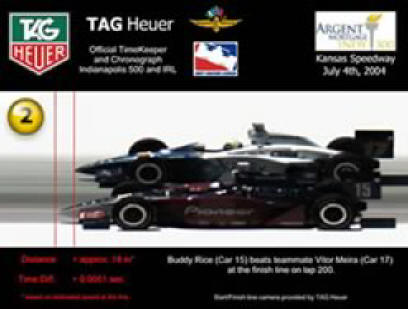
SUSPENSION & WHEEL ENERGY
MANAGEMENT SYSTEM (SWEMS):
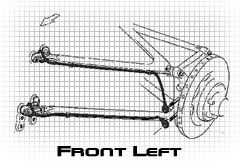 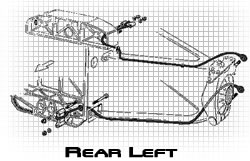
The
Suspension
& Wheel
Energy
Management
System has
been required on every car since the 83rd Indianapolis 500. The
SWEMS principle utilizes multiple restraints attached at multiple
points to a car's chassis and suspension to minimize the
possibilities of wheel assemblies becoming detached during
high-speed accidents. The SWEMS was applied to rear-wing assembly in
2001.
WING CONFIGURATIONS:
During the 2006 season, Indy Pro Series teams will employ two
rear-wing configurations. The rear-wing package varies according to
track.
Superspeedway Wing

Short Track, Road & Street Course Wing
Consists of the standard mainplane with a top flap. The IRL-designated
minimum flap angle varies according to track. The two-element wing
increases downforce and drag and limits speeds.
SAFER INNOVATIONS:
2003:
All cars are equipped with a device that measures and communicates
the impact of a crash to rescue and safety workers on the scene.
Controlled by Delphi's Accident Data Recorder, a light illuminates
when a crash reaches or exceeds a pre-set threshold, informing
safety workers that an injury is more likely.
2002: The
SAFER (Steel and Foam Energy Reduction) Barrier is installed in all
four corners of the Indianapolis Motor Speedway prior to the
beginning of practice for the 86th Indianapolis 500. Under
development by the Indy Racing League and the University of
Nebraska-Lincoln's Midwest Roadside Safety Facility since 1998, the
SAFER barrier is designed to reduce the severity of impacts by Indy
Racing League cars.
2000:
Collapsible steering columns are introduced.
2000:
Delphi Accident Data Recorders are installed in all IndyCar Series
cars.
1999: The
Suspension & Wheel Energy Management System is required on every car
for the 83rd Indianapolis 500. The SWEMS principle utilizes multiple
restraints attached at multiple points to a car's chassis and
suspension to minimize the possibilities of wheel assemblies
becoming detached during high-speed accidents. The SWEMS was applied
to rear-wing assembly in 2001.
1998:
Attenuators are added to the rear of the Indy Racing League
gearboxes to lessen g-forces in rear-impact crashes.
1998: Indy
Racing League technical staff and Delphi Automotive Systems
engineers develop a yellowlight warning system. When a caution is
called on the track, a yellow light blinks in the cockpit, providing
the driver with immediate notifi cation of the caution. The system
is fi rst used at the 82nd Indianapolis 500.
|

